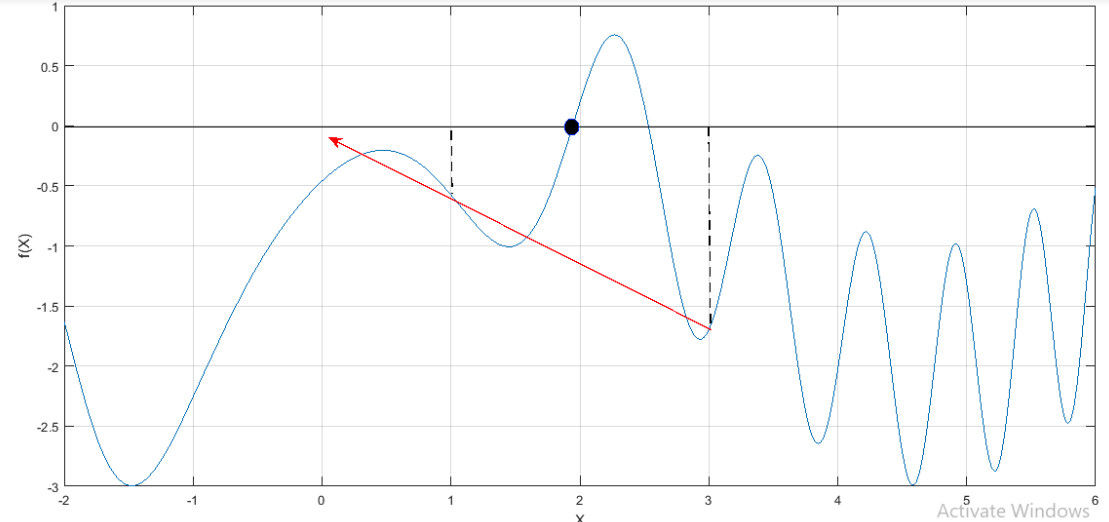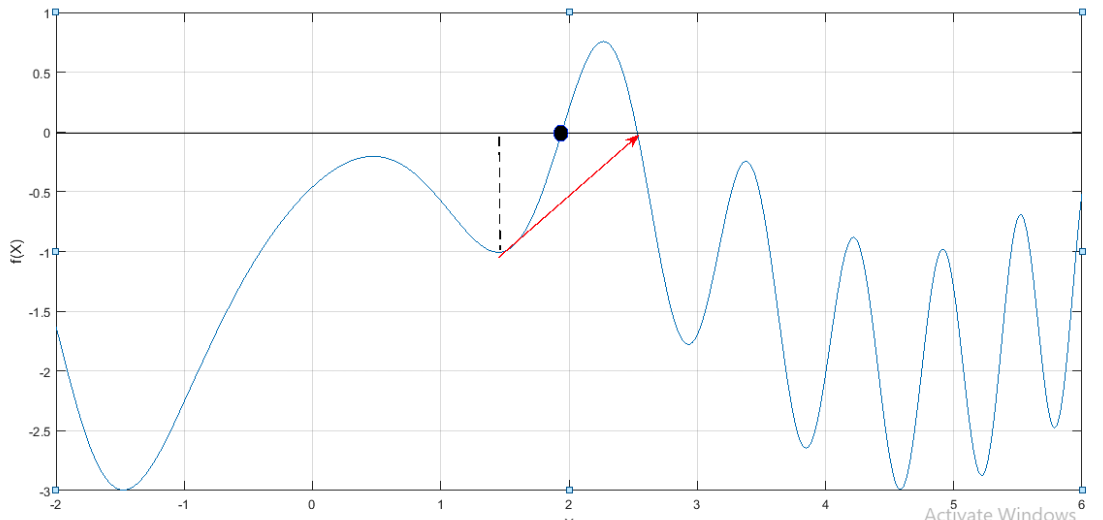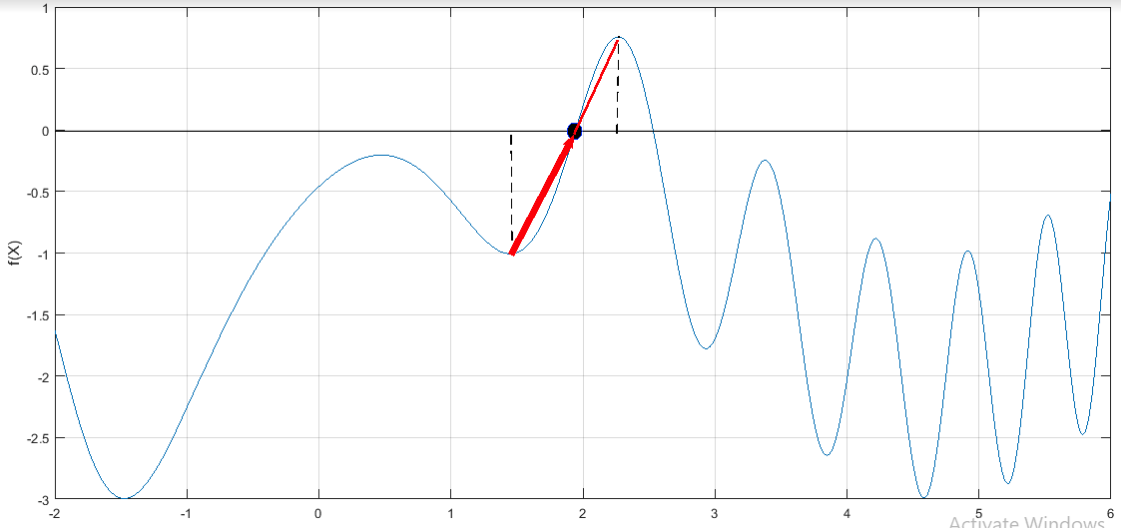
Locate the first positive root of
Where x is in radians. Use four iterations of the secant method with initial guesses of (a)
(a)
To calculate: Thefirst positive root of the function
Answer to Problem 7P
Solution:
The first positive root of the function
Explanation of Solution
Given Information:
The function,
Formula used:
The iterative equation of secant method is,
And, formula for approximate error is,
Calculation:
Consider the function,
For
Therefore, the approximate error is,
Use
Therefore, the approximate error is,
Use
Therefore, the approximate error is,
Use
Therefore, the approximate error is,
Similarly, all the iteration can be summarized as below,
| 0 | 3 | |
| 1 | ||
| 2 | ||
| 3 | ||
| 4 |
Hence, the first positive root is
(b)
To calculate: The first positive root of the function
Answer to Problem 7P
Solution:
The first positive root of the function
Explanation of Solution
Given Information:
The function,
Formula used:
The iterative equation of secant method is,
And, formula for approximate error is,
Calculation:
Consider the function,
For
Therefore, the approximate error is,
Use
Therefore, the approximate error is,
Use
Therefore, the approximate error is,
Use
Therefore, the approximate error is,
Similarly, all the iteration can be summarized as below,
| 0 | 2.5 | |
| 1 | ||
| 2 | ||
| 3 | ||
| 4 |
Hence, the first positive root is
(c)
To calculate: The first positive root of the function
Answer to Problem 7P
Solution:
The first positive root of the function
Explanation of Solution
Given Information:
The function,
Formula used:
The iterative equation of secant method is,
And, formula for approximate error is,
Calculation:
Consider the function,
For
Therefore, the approximate error is,
Use
Therefore, the approximate error is,
Use
Therefore, the approximate error is,
Use
Therefore, the approximate error is,
Similarly, all the iteration can be summarized as below,
| 0 | ||
| 1 | 16.76% | |
| 2 | ||
| 3 | ||
| 4 |
Hence, the first positive root is
(d)
The explanation of the result obtained by the secant method of the function
Answer to Problem 7P
Solution:
For the initial guesses
For the initial guesses
For the initial guesses
Explanation of Solution
Given Information:
The function,
Consider the function,
From part (a), the result obtained with the initial guesses
| 0 | 3 | |
| 1 | ||
| 2 | ||
| 3 | ||
| 4 |
Use MATLAB to draw the graph of the function as below,
Code:
function f = g(x)
% f is assigned a value of function f(x).
f=sin(x)+cos(1+(x^2))-1;
%function is defined.
end
Output:

The graph obtained is,

From the graph, it is observed that the first iteration gives a negative value due to the improper choice of initial guess.
From part (b), the result obtained with the initial guesses
| 0 | 2.5 | |
| 1 | ||
| 2 | ||
| 3 | ||
| 4 |
Use MATLAB to draw the graph of the function as below,
Code:
function f = g(x)
% f is assigned a value of function f(x).
f=sin(x)+cos(1+(x^2))-1;
%function is defined.
end
Output:

The graph obtained is,

From the graph, it is observed that the root is converges towards the second positive root with these initial guesses instead of first positive root.
From part (c), the result obtained with the initial guesses
| 0 | ||
| 1 | 16.76% | |
| 2 | ||
| 3 | ||
| 4 |
Use MATLAB to draw the graph of the function as below,
Code:
function f = g(x)
% f is assigned a value of function f(x).
f=sin(x)+cos(1+(x^2))-1;
%function is defined.
Output:

The graph obtained is,

From the graph, it is observed that the root is converges towards the first positive root with these initial guesses rapidly. Hence, these guesses are the proper selection to locate the first positive root by secant method.
Want to see more full solutions like this?
Chapter 6 Solutions
EBK NUMERICAL METHODS FOR ENGINEERS
Additional Engineering Textbook Solutions
Basic Technical Mathematics
Advanced Engineering Mathematics
Fundamentals of Differential Equations (9th Edition)
Elementary Statistics Using Excel (6th Edition)
- Consider the function p(x) = x² - 4x³+3x²+x-1. Use Newton-Raphson's method with initial guess of 3. What's the updated value of the root at the end of the second iteration? Type your answer...arrow_forward6 108 polynomial is used to approximate v8, the answer is: dy 13. of the parametric equations x: 2-3t 3+2t and y =- is dx Use the following information for Questions 14 and 15: 1+t 1+t Using the Newton-Raphson method to determine the critical co-ordinate of the graph y=f(x)=(x)*an (*) (in words x to the power of tan (x)), you will be required to determine f'(x) 14. The expression for f'(x) is: The following tools were required in determining an expression for f'(x): Application of the natural logarithm 15. I. II. The product rule III. Implicit differentiationarrow_forwardProblem #3 Determine the roots of f (x) =-12 – 21x + 18x² – 2.75x³ using the false-position method, with initial guesses of xi=-1 and xu = 0 and a stopping criterion of 1%. f(xu)(xl – xu) f(x1) – f(xu) X, = xu –arrow_forward
- Ex.15: Compute the temperature distribution in a rod that is heated at both ends as depicted in the following figure. Use Gauss- Seidel method given that:- T₁+2T₁+T₁_₁ = 0 where T, represents the temperature at any nodal point. Perform your calculation correct to five decimal places, and use (T = 0) as an initial guess. To = -10 °C T₁ x T₂ T3 Ts = 10 °Carrow_forwardT(1)=199.583 T(2)=198.67 T(3)=195.7569 Solve Using Finite Elemental method only need step wise step and correct ansarrow_forwardFor the equation: a. Secant Method. Use Secant Method to determine the root of the given function up to three iterations use x_1= 0 and xo = 2. Complete the table using the HAND Calculation. Maintain 6 decimal places XH ex = 3 f(x+1) X₁ f(x₁) Eaarrow_forward
- The natural exponential function can be expressed by . Determine e2by calculating the sum of the series for:(a) n = 5, (b) n = 15, (c) n = 25For each part create a vector n in which the first element is 0, the incrementis 1, and the last term is 5, 15, or 25. Then use element-by-element calculations to create a vector in which the elements are . Finally, use the MATLAB built-in function sum to add the terms of the series. Compare thevalues obtained in parts (a), (b), and (c) with the value of e2calculated byMATLAB.arrow_forwardUse a step size of 0.1 and round your answers to five decimal places if needed. Use Euler's method to approximate the solution x10 for the IVP y' 8y, y(0) 1. The Euler approximation for x10 isarrow_forwardf(x)=-0.9x? +1.7x+2.5 Calculate the root of the function given below: a) by Newton-Raphson method b) by simple fixed-point iteration method. (f(x)=0) Use x, = 5 as the starting value for both methods. Use the approximate relative error criterion of 0.1% to stop iterations.arrow_forward
- FOLLOW THESE STEPS FOR UPVOTE Given Required Diagram Solution Conclusion Do not round off while solving. Question: Consider the figure below. Each tank has a volume of 10 ft³. Conditions on each tank are tabulated as follow: Tank No. 1 2 3 TANK 1 Content Methane Propane Hexane Pressure 70 psia 21 psia 43 psia TANK 1 Temperature 160°F 124°F 110°F TANK 1 k 1.32 1.24 1.39 All separation valves have been opened at the same time. Determine the resulting temperature in °F at equilibrium.arrow_forwardGIVEN: L1=20 N GIVEN: a= 4m GIVEN: L2= 20 N GIVEN: b= 5m GIVEN: L3=20 N GIVEN: c= 6m GIVEN: L4= 0 N GIVEB: e= 3m GIVEN: L5= 10 N ANSWER: (a) Ax in N (b) Ay in N (c) Ex in N (d) Ey in N PLS SOLVE IN A COMPLETE SOLUTION AND WRITE LEGIBLY AND ALSO DRAW THE FREE BODY DIAGRAMarrow_forwardSolve the Following Linear Equation Using Gauss Method: 3X₁ + 2X₂+ 100X; = 105 -X₁+3X₂ + 100X3 = 102 X₁ + 2X₂ X3 = 2 a) (0,0,0) b) (1,1,1) d) (5,5,5) c) (10.10.10)arrow_forward
 Elements Of ElectromagneticsMechanical EngineeringISBN:9780190698614Author:Sadiku, Matthew N. O.Publisher:Oxford University Press
Elements Of ElectromagneticsMechanical EngineeringISBN:9780190698614Author:Sadiku, Matthew N. O.Publisher:Oxford University Press Mechanics of Materials (10th Edition)Mechanical EngineeringISBN:9780134319650Author:Russell C. HibbelerPublisher:PEARSON
Mechanics of Materials (10th Edition)Mechanical EngineeringISBN:9780134319650Author:Russell C. HibbelerPublisher:PEARSON Thermodynamics: An Engineering ApproachMechanical EngineeringISBN:9781259822674Author:Yunus A. Cengel Dr., Michael A. BolesPublisher:McGraw-Hill Education
Thermodynamics: An Engineering ApproachMechanical EngineeringISBN:9781259822674Author:Yunus A. Cengel Dr., Michael A. BolesPublisher:McGraw-Hill Education Control Systems EngineeringMechanical EngineeringISBN:9781118170519Author:Norman S. NisePublisher:WILEY
Control Systems EngineeringMechanical EngineeringISBN:9781118170519Author:Norman S. NisePublisher:WILEY Mechanics of Materials (MindTap Course List)Mechanical EngineeringISBN:9781337093347Author:Barry J. Goodno, James M. GerePublisher:Cengage Learning
Mechanics of Materials (MindTap Course List)Mechanical EngineeringISBN:9781337093347Author:Barry J. Goodno, James M. GerePublisher:Cengage Learning Engineering Mechanics: StaticsMechanical EngineeringISBN:9781118807330Author:James L. Meriam, L. G. Kraige, J. N. BoltonPublisher:WILEY
Engineering Mechanics: StaticsMechanical EngineeringISBN:9781118807330Author:James L. Meriam, L. G. Kraige, J. N. BoltonPublisher:WILEY





